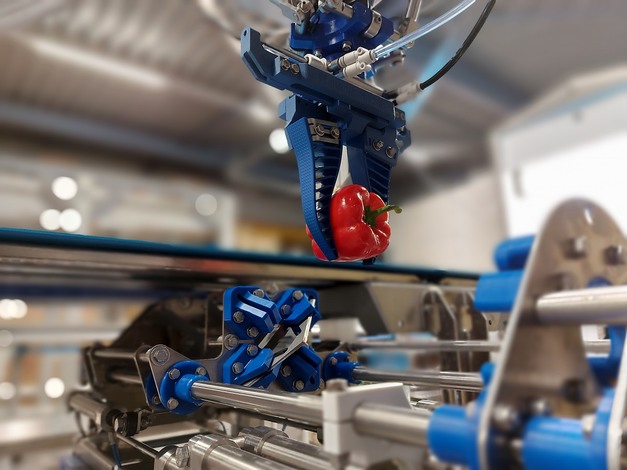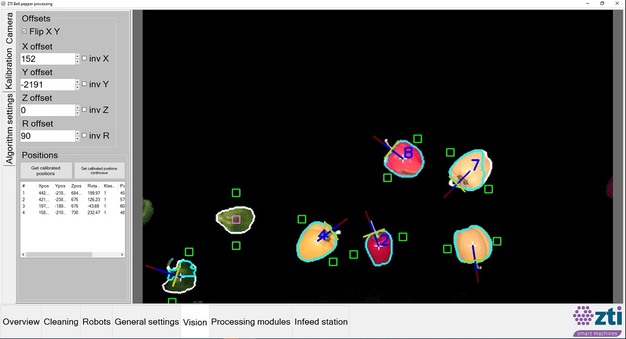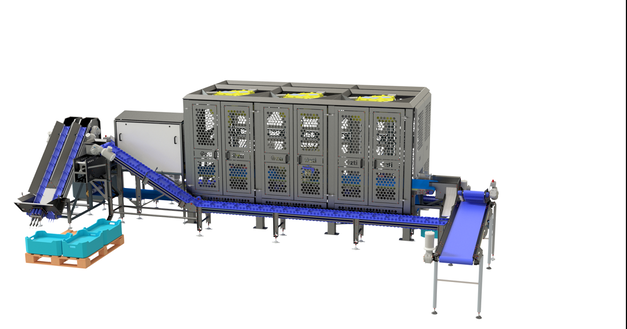"No people work on our bell pepper line anymore," begins Machiel Honig, co-owner of ZTI Smart Machines. This Dutch company develops machines for different sectors, including fruit and vegetable processing. "It tips over crates of bell peppers that are eventually processed into half of quartered, de-cored bell peppers. In this new processing line, cameras inspect the bell peppers, which a robotic silicon gripper then picks up."
 ZTI employee at new fully automatic pepper line
ZTI employee at new fully automatic pepper line
"Thanks to this vision technology, the robot knows exactly how to position the bell pepper for the de-coring unit. That then removes the core with extreme precision. After that, the bell pepper can be cut into two or four equal parts," says Machiel. Hans Keijzer, the company's other co-owner, points out that this process automation combats high losses. "You can't expect people to consistently place bell peppers on the machine for hours on end. A robot doesn't make mistakes and never gets tired," he says.
Repetitive motion
This automated working method saves considerably on labor, too, notes Machiel, which he considers one of the biggest drivers for automating bell pepper processing. "But the work's repetitive nature also plays a role," says Hans. "Doing the same movement for hours isn't the best work for long-term health." Besides saving on labor - he sees the potential of cutting back at least two workers - sustainability is another crucial component. "We collect a lot of data on, in this case, bell peppers, so we can give the operator feedback. If a particular batch has some smaller fruits, they can say, use a slightly smaller drill to retain more bell pepper," Hans explains.
 Thanks to vision technology, the robot knows exactly how the pepper should be positioned for the coring unit
Thanks to vision technology, the robot knows exactly how the pepper should be positioned for the coring unit
Further possibilities
This packaging line was initially developed for bell peppers, but Michiel sees plenty of possibilities for it to process other fruits and vegetables. "The technology we use, a combination of vision technology, robotics, and deep learning, isn't limited to peppers. With different options, you can use our machine for other products as well." According to Hans, the bell pepper line will be marketed as a modular package. He says depending on the process, the capacity required, and the space available, you can choose components and the level of automation. "You could still use some manual labor for some parts, which you can automate later if you like. But no matter how the line is set up, it will be beneficial."
 In this new ZTI processing line, the peppers are viewed with a camera
In this new ZTI processing line, the peppers are viewed with a camera
Health and Safety
Machiel adds that they bore energy use in mind during the development phase. "That plays a role. We calculate energy consumption to an optimum, so you use no more than is strictly necessary," he continues. Hygiene, too, was considered from the concept phase. "You can use the cleaning-in-place method in the process. We can temporarily run the robot on another module." Because the line employs robots, you need less safety shielding, which makes the machine easier to clean. "There's a huge open view of the machine's inner workings, which is an advantage for hygiene and maintenance," Hans adds.

The techniques used also contribute to employee safety, Machiel points out. "This processing line makes creating distance between the knives and people easier. With other machines, the measures needed to achieve a safe workplace involve considerable costs. We use robots, and the process ends in a shielded area. So, it's easier to keep operators away from the blades, especially when the machine runs fully autonomously."
For more information:
Machiel Honing
Machiel.Honig@zti.nl Hans Keijzer
Hans.Keijzer@zti.nl
ZTI
Tel.: +31 (0)224 55 33 00
info@zti.nl
www.zti.nl
